|
|
Saint Euthymius The Great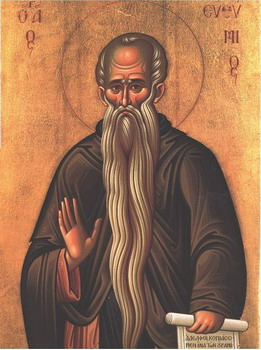 Of noble and distinguished parents, Euthymius was born in the Armenian town of Melitene near the Euphrates river about the year 377 A.D. He was the only child, a son, born in answer to the prayer of his mother Dionisiya, who had a heavenly vision regarding the birth of Euthymius. From his youth, he lived a life of asceticism, at first in the proximity of his town [Melitene] but then, after he visited Jerusalem at age twenty-nine, in the desert between Jerusalem and Jericho called Pharan. He filled his days and nights with prayer, internal thoughts about God, contemplation and physical exertion. Around him many disciples gathered some of whom are glorious saints, such as Cyriac the Hermit, St. Sabas the Sanctified, Theotictus and others. By God's gift, Euthymius was a great miracle worker; he expelled demons, healed the gravely ill, brought water to the desert, multiplied bread and prophesied. He taught monks the love of labor saying, "If you eat bread, not of your own labor, know that you are eating of someone else's labor." When some of the younger monks wanted to fast more than others, he forbade them to do so and commanded them to come to the communal table so that they would not become prideful as a result of their excessive fasting. He also said that it was not good for a monk to move from place to place, for he said, " A tree frequently transplanted does not bear fruit. Whoever desires to do good, can do it from the place where he is."
About love, he said, "What salt is to bread, love is to other virtues." During the first week of the Honorable Fast [Lenten Season], he retreated to the desert and remained there in solitary silence and godly-thoughts until just before the Feast of the Resurrection. During his life time, a large monastery [Lavra] was established in the proximity of his cave which later, throughout the centuries, was completely filled with monks as a beehive is filled with bees. His final command was that the monastery always adhere to hospitality and that the gates of the monastery never be closed. He died at the age of ninety-seven. The Patriarch of Jerusalem was in attendance at his funeral. The patriarch waited all day long until the great masses of people reverenced the body of the saint and only in the evening were they able to complete the Office for Burial for the Dead. On the seventh day following his death, Euthymius appeared radiant and rejoicing to Domentian, his disciple. The Venerable Euthymius, in truth, was a true "son of Light". He died in the year 473 A.D. Of noble and distinguished parents, Euthymius was born in the Armenian town of Melitene near the Euphrates river about the year 377 A.D. He was the only child, a son, born in answer to the prayer of his mother Dionisiya, who had a heavenly vision regarding the birth of Euthymius. From his youth, he lived a life of asceticism, at first in the proximity of his town [Melitene] but then, after he visited Jerusalem at age twenty-nine, in the desert between Jerusalem and Jericho called Pharan. He filled his days and nights with prayer, internal thoughts about God, contemplation and physical exertion. Around him many disciples gathered some of whom are glorious saints, such as Cyriac the Hermit, St. Sabas the Sanctified, Theotictus and others. By God's gift, Euthymius was a great miracle worker; he expelled demons, healed the gravely ill, brought water to the desert, multiplied bread and prophesied. He taught monks the love of labor saying, "If you eat bread, not of your own labor, know that you are eating of someone else's labor." When some of the younger monks wanted to fast more than others, he forbade them to do so and commanded them to come to the communal table so that they would not become prideful as a result of their excessive fasting. He also said that it was not good for a monk to move from place to place, for he said, " A tree frequently transplanted does not bear fruit. Whoever desires to do good, can do it from the place where he is."
About love, he said, "What salt is to bread, love is to other virtues." During the first week of the Honorable Fast [Lenten Season], he retreated to the desert and remained there in solitary silence and godly-thoughts until just before the Feast of the Resurrection. During his life time, a large monastery [Lavra] was established in the proximity of his cave which later, throughout the centuries, was completely filled with monks as a beehive is filled with bees. His final command was that the monastery always adhere to hospitality and that the gates of the monastery never be closed. He died at the age of ninety-seven. The Patriarch of Jerusalem was in attendance at his funeral. The patriarch waited all day long until the great masses of people reverenced the body of the saint and only in the evening were they able to complete the Office for Burial for the Dead. On the seventh day following his death, Euthymius appeared radiant and rejoicing to Domentian, his disciple. The Venerable Euthymius, in truth, was a true "son of Light". He died in the year 473 A.D.The Holy Martyrs Innas, Nirras And Pinnas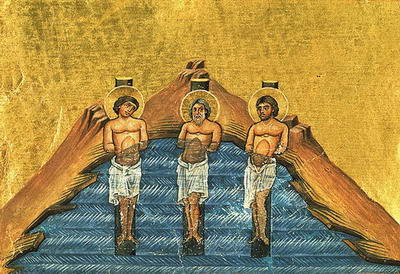 They are considered to be the first Slavic martyrs who are mentioned in history. They are referred to as Scythians and disciples of St. Andrew the Apostle. They suffered for the Faith at the hands of their pagan neighbors on the right side of the Danube river near Varna. Tied up on the ice, Innas, Nirras and Pinnas froze and died in the Lord. They are considered to be the first Slavic martyrs who are mentioned in history. They are referred to as Scythians and disciples of St. Andrew the Apostle. They suffered for the Faith at the hands of their pagan neighbors on the right side of the Danube river near Varna. Tied up on the ice, Innas, Nirras and Pinnas froze and died in the Lord.Martyrs Bassus, Eusebius, Eutychius, and Basilides, at Nicomedia (303) 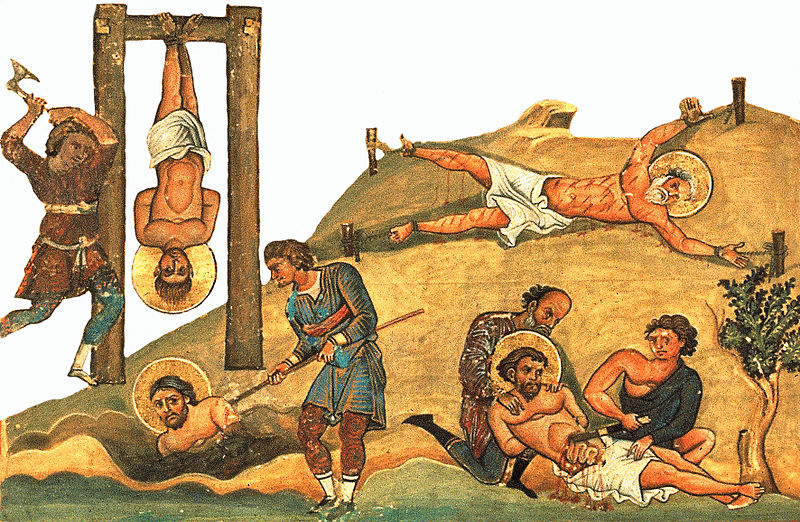 The Holy Martyrs Bassos, Eusebios, Eutykhios and Basilides were courtiers of the emperor Diocletian. He sent them as witnesses of the suffering of the Nicomedia bishop Theopemptos (Comm. 5 January) for his faith in Christ. They themselves came to believe and accepted holy Baptism. For this they were subjected to tortures and condemned to death. Saint Bassos they buried in the ground and hacked at him; Saint Eusebios they hung head downwards and cut him in two; Saint Eutykhios they tied hands and legs to a pillar and broke him apart; Saint Basilides they cut in the stomach with a knife. The martyrs suffered in the year 303. The Holy Martyrs Bassos, Eusebios, Eutykhios and Basilides were courtiers of the emperor Diocletian. He sent them as witnesses of the suffering of the Nicomedia bishop Theopemptos (Comm. 5 January) for his faith in Christ. They themselves came to believe and accepted holy Baptism. For this they were subjected to tortures and condemned to death. Saint Bassos they buried in the ground and hacked at him; Saint Eusebios they hung head downwards and cut him in two; Saint Eutykhios they tied hands and legs to a pillar and broke him apart; Saint Basilides they cut in the stomach with a knife. The martyrs suffered in the year 303.Martyrs Inna, Pinna, and Rimma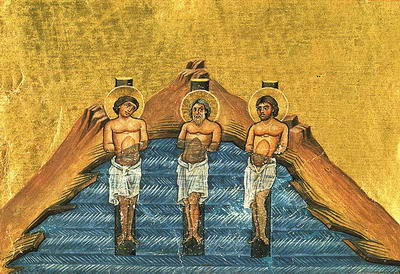 The Holy Martyrs Inna, Pinna and Rimma, – Slavs by birth from northern Skythia, – they were disciples of the holy Apostle Andrew the First-Called. They taught about the Name of Christ and they baptised many barbarians converted to the true faith. For this there were seized by the local prince, but they would not recant from Christ nor would they offer sacrifice to idols. A fierce winter then prevailed; the rivers were so solid with frost, that on the ice there travelled not only people, but also horses with carts. The prince gave orders to put large timbers on the ice and bind the saints to them, gradually lowering them into the freezing water. When the ice reached the necks of the saints they, worn out by the terrible cold, offered to the Lord their blessed souls. The Holy Martyrs Inna, Pinna and Rimma, – Slavs by birth from northern Skythia, – they were disciples of the holy Apostle Andrew the First-Called. They taught about the Name of Christ and they baptised many barbarians converted to the true faith. For this there were seized by the local prince, but they would not recant from Christ nor would they offer sacrifice to idols. A fierce winter then prevailed; the rivers were so solid with frost, that on the ice there travelled not only people, but also horses with carts. The prince gave orders to put large timbers on the ice and bind the saints to them, gradually lowering them into the freezing water. When the ice reached the necks of the saints they, worn out by the terrible cold, offered to the Lord their blessed souls.New Martyr Zachariah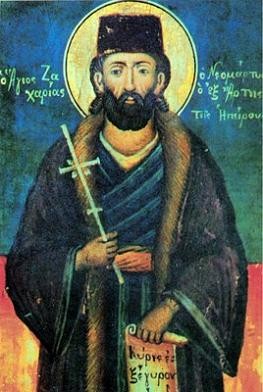 The Holy New Martyr Zachariah was from the Peloponnesos in Greece. He renounced Christ to become a Moslem, then went to ancient Patras and worked there as a furrier. He had a book, THE SALVATION OF SINNERS, which he often read. The book moved him to repentence, and he wept bitterly for the great evil he had done.
St Zachariah met a certain Elder and told him of his sin. After praying and fasting for twenty days, he returned to the Elder and confessed all the sins he had committed during his life. When he asked the Elder’s blessing to seek martyrdom, the holy man tried to discourage him. He warned that he might not be killed swiftly, but only after much torture. He also pointed out the danger that Zachariah would betray Christ a second time under the torments he would endure. The saint, aflame with zeal for martyrdom, said he was prepared to suffer myriad punishments for the sake of Christ.
The Elder read the prayers of absolution and chrismated the saint (as is done when apostates from the Faith are received back into the Church), then administered the Holy Mysteries to him. Then he blessed Zachariah to go back to the Moslems and declare his faith in Christ. On his way, the saint asked forgiveness from each Christian he met.
The holy martyr went to the judge’s house and said that he had been deceived when he accepted their religion, but now he had come to his senses and returned to Christ. St Zachariah was thrown into prison, where he was beaten three times a day.
Finally, the saint died by being stretched out on a rack. Christians asked for his body so they might bury it, but the Moslems refused. They said, “He is neither one of you, nor one of us, for he denied both religions. Therefore, he is unworthy of burial.” His body was dragged through the streets and thrown into a dry well, landing on its knees in an upright position. Christians saw a radiant light over the well the next night, and hastened to venerate the saint. The Turks filled the well with dirt and debris to prevent such gatherings in the future.
By shedding his blood, the holy New Martyr Zachariah washed away the sin of his denial of Christ and received an unfading crown of glory in the year 1782. The Holy New Martyr Zachariah was from the Peloponnesos in Greece. He renounced Christ to become a Moslem, then went to ancient Patras and worked there as a furrier. He had a book, THE SALVATION OF SINNERS, which he often read. The book moved him to repentence, and he wept bitterly for the great evil he had done.
St Zachariah met a certain Elder and told him of his sin. After praying and fasting for twenty days, he returned to the Elder and confessed all the sins he had committed during his life. When he asked the Elder’s blessing to seek martyrdom, the holy man tried to discourage him. He warned that he might not be killed swiftly, but only after much torture. He also pointed out the danger that Zachariah would betray Christ a second time under the torments he would endure. The saint, aflame with zeal for martyrdom, said he was prepared to suffer myriad punishments for the sake of Christ.
The Elder read the prayers of absolution and chrismated the saint (as is done when apostates from the Faith are received back into the Church), then administered the Holy Mysteries to him. Then he blessed Zachariah to go back to the Moslems and declare his faith in Christ. On his way, the saint asked forgiveness from each Christian he met.
The holy martyr went to the judge’s house and said that he had been deceived when he accepted their religion, but now he had come to his senses and returned to Christ. St Zachariah was thrown into prison, where he was beaten three times a day.
Finally, the saint died by being stretched out on a rack. Christians asked for his body so they might bury it, but the Moslems refused. They said, “He is neither one of you, nor one of us, for he denied both religions. Therefore, he is unworthy of burial.” His body was dragged through the streets and thrown into a dry well, landing on its knees in an upright position. Christians saw a radiant light over the well the next night, and hastened to venerate the saint. The Turks filled the well with dirt and debris to prevent such gatherings in the future.
By shedding his blood, the holy New Martyr Zachariah washed away the sin of his denial of Christ and received an unfading crown of glory in the year 1782. Martyrs Thyrsus and Agnes
Saint Leo the Great (Leo Marcellus)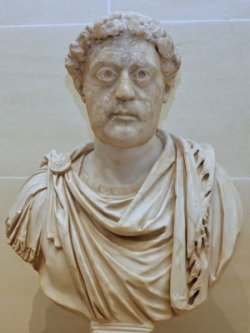 He was born Leo Marcellus in Thracia or in Dacia Aureliana province in the year 401 to a Thraco-Roman family. His Dacian origin is mentioned by Candidus Isaurus, while John Malalas believes that he was of Bessian stock. He served in the Roman army, rising to the rank of comes. Leo was the last of a series of emperors placed on the throne by Aspar, the Alan serving as commander-in-chief of the army, who thought Leo would be an easy puppet ruler. Instead, Leo became more and more independent from Aspar, causing tension that would culminate in the assassination of the latter.
Leo's coronation as emperor on 7 February 457, was the first known to involve the Patriarch of Constantinople. Leo I made an alliance with the Isaurians and was thus able to eliminate Aspar. The price of the alliance was the marriage of Leo's daughter to Tarasicodissa, leader of the Isaurians who, as Zeno, became emperor in 474. In 469, Aspar attempted to assassinate Zeno and very nearly succeeded. Finally, in 471, Aspar's son Ardabur was implicated in a plot against Leo and both were killed by palace eunuchs acting on Leo's orders.
Leo overestimated his capacities and he made some errors that menaced the internal order of the Empire. The Balkans were ravaged by the Ostrogoths, after a disagreement between the Emperor and the young chief Theodoric the Great who had been raised at Leo's court in Constantinople, where he was steeped in Roman government and military tactics. There were also some raids by the Huns. However, these attackers were unable to take Constantinople thanks to the walls, which had been rebuilt and reinforced in the reign of Theodosius II and against which they possessed no suitable siege engines.
Leo's reign was also noteworthy for his influence in the Western Roman Empire, marked by his appointment of Anthemius as Western Roman Emperor in 467. He attempted to build on this political achievement with an expedition against the Vandals in 468, which was defeated due to the arrogance of Leo's brother-in-law Basiliscus. This disaster drained the Empire of men and money. The expedition, which cost 130,000 pounds of gold and 700 pounds of silver, consisted of 1,113 ships carrying 100,000 men, but in the end lost 600 ships. After this defeat, Vandals raided Greek coasts until a costly peace agreement was signed between Leo and Genseric.
Leo became very unpopular on his last days as Emperor for abolishing any non-religious celebration or event on Sundays.
Leo died of dysentery at the age of 73 on 18 January 474. He was born Leo Marcellus in Thracia or in Dacia Aureliana province in the year 401 to a Thraco-Roman family. His Dacian origin is mentioned by Candidus Isaurus, while John Malalas believes that he was of Bessian stock. He served in the Roman army, rising to the rank of comes. Leo was the last of a series of emperors placed on the throne by Aspar, the Alan serving as commander-in-chief of the army, who thought Leo would be an easy puppet ruler. Instead, Leo became more and more independent from Aspar, causing tension that would culminate in the assassination of the latter.
Leo's coronation as emperor on 7 February 457, was the first known to involve the Patriarch of Constantinople. Leo I made an alliance with the Isaurians and was thus able to eliminate Aspar. The price of the alliance was the marriage of Leo's daughter to Tarasicodissa, leader of the Isaurians who, as Zeno, became emperor in 474. In 469, Aspar attempted to assassinate Zeno and very nearly succeeded. Finally, in 471, Aspar's son Ardabur was implicated in a plot against Leo and both were killed by palace eunuchs acting on Leo's orders.
Leo overestimated his capacities and he made some errors that menaced the internal order of the Empire. The Balkans were ravaged by the Ostrogoths, after a disagreement between the Emperor and the young chief Theodoric the Great who had been raised at Leo's court in Constantinople, where he was steeped in Roman government and military tactics. There were also some raids by the Huns. However, these attackers were unable to take Constantinople thanks to the walls, which had been rebuilt and reinforced in the reign of Theodosius II and against which they possessed no suitable siege engines.
Leo's reign was also noteworthy for his influence in the Western Roman Empire, marked by his appointment of Anthemius as Western Roman Emperor in 467. He attempted to build on this political achievement with an expedition against the Vandals in 468, which was defeated due to the arrogance of Leo's brother-in-law Basiliscus. This disaster drained the Empire of men and money. The expedition, which cost 130,000 pounds of gold and 700 pounds of silver, consisted of 1,113 ships carrying 100,000 men, but in the end lost 600 ships. After this defeat, Vandals raided Greek coasts until a costly peace agreement was signed between Leo and Genseric.
Leo became very unpopular on his last days as Emperor for abolishing any non-religious celebration or event on Sundays.
Leo died of dysentery at the age of 73 on 18 January 474. |